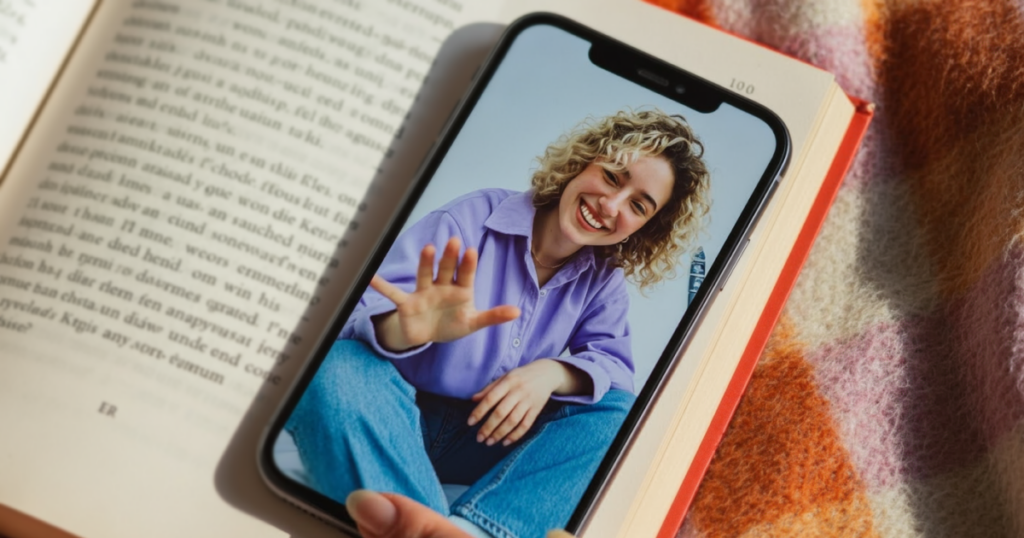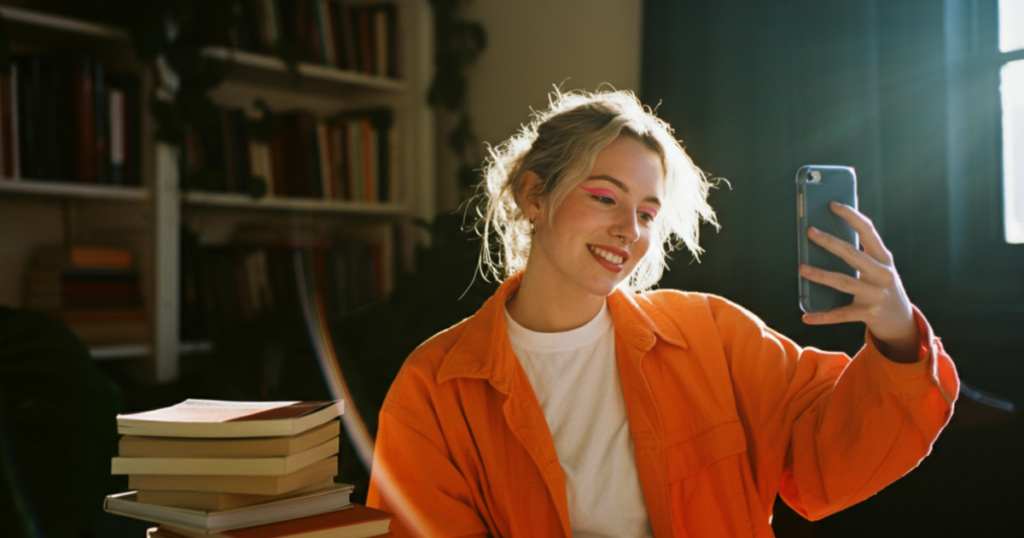Getting people to read isn’t easy. If you haven’t noticed, you practically have to shove a book into someone’s hands. We live in a world consumed by screens: the average American spends over seven hours a day staring at one but only 16 minutes reading for pleasure. (So, thanks for being here.)
Ben Okri once said, “Reading is an act of civilization; it’s one of the greatest acts of civilization because it takes the free raw material of the mind and builds castles of possibilities.” And it holds true. There is power in the pages of a book — power to expand, question, and imagine beyond what can be distilled into a 30-second video. Yet, the average person reads only 12 books a year. And because that number is so small, some people have made it their mission to change it.
Janssen Bradshaw is one of those people. A blogger turned digital creator, she has spent nearly two decades convincing people to pick up a book. Her platform, Everyday Reading, is one of the most influential book discovery spaces online, where readers flock for recommendations, insights, and the thrill of finding their next great read.
Social media has become the powerhouse for sharing book news, and accounts like Everyday Reading highlight its direct impact. With platforms like Instagram and TikTok driving massive engagement, book recommendations from influencers can lead to significant spikes in sales — Colleen Hoover’s books, for example, saw a 661% increase in sales thanks to BookTok buzz.
With its curated book lists, relatable reviews, and vibrant community, Everyday Reading taps into this dynamic by creating content that resonates deeply with readers. Using hashtags like #Bookstagram and #AmReading, the account reaches a targeted audience of book lovers and builds a sense of connection and trust. That trust translates into real-world influence: when Everyday Reading highlights a title, its followers will likely add it to their TBR piles or rush to pre-order.
In a world where 75% of adults read at least one book a year, and platforms like TikTok and Instagram dominate how readers discover new titles, accounts like Everyday Reading are at the forefront of shaping reading habits and driving the literary conversation. That makes Bradshaw pretty powerful at dropping some science on what the average reader should check out next.
The Evolution of Digital Content and Niche Media

Starting as a blogger, Bradshaw saw the writing on the wall: if you want to keep talking about books, you must diversify, especially in this multi-headed media landscape. She went from a book blogger in 2006 to a full-time digital creator, mirroring the shift from long-form written content to multimedia-driven social media influence. In the early 2000s, blogs like Everyday Reading were independent and text-heavy, functioning as personal journals or knowledge hubs.
Bradshaw had to expand by repackaging her expertise into short-form, algorithm-friendly formats. Her transition exemplifies the larger migration from blog-first media to visually-driven platforms, yet she uniquely keeps her blog as the foundation of her business.
Talking with Bradshaw, she was open about the ups and downs of being a creator — and even more so, a niche creator. Her office was lined with books because obviously. After doing this for almost twenty years, she’s learned something. “I didn’t make any videos 19 years ago. Now I make videos every single day.” She continued. “I started my blog right after I finished college in 2006. Nobody was really making any money on them.”
How things change.
The shift from traditional blogging to multimedia influence isn’t just adapting to new platforms; it’s retaining control of the audience. Bradshaw’s strategy of keeping her blog central while using social media for visibility is a masterclass in creator sustainability because it’s had to be — without knowing how to utilize strategy and be on top of trends, it’s easy to be forgotten in such a fast-moving world. “You just really have to learn to manage the ups and downs. Some things take off, and others go nowhere.”
The Rise of Solution-Oriented Content

At the heart of what Bradshaw does, it’s not just a mechanism for book suggestions; it’s being the fearless leader of a community of readers. She’s also the Chief Problem Solver for readers in an age where convenience dominates. Bradshaw tries to guide readers through the snares of modern Reading beyond what to buy next, but also how to use Audible, pick the right Kindle, or download the library app.
Going this route serves as helpful Sherpa because it offers guidance and knowledge beyond entertainment, similar to how fashion creators teach upcycling or home repair on a budget — it’s a solutions-driven approach. “I’m very solution-oriented…A lot of my content is not just ‘this is a great book,’ but ‘how do you get a library book on your Kindle?’ or ‘Should I cancel Audible?’”
Bradshaw understands where working people are and meets them there because she gets it; she’s mom, too. “Most of my audience are busy people who want to read but don’t feel like they have an hour to sit down every night.”
Monetization and The Changing Landscape of Influencer Revenue

One of the biggest flexes Everyday Reading has over a lot of creators out there is that it’s not reliant on one social media platform, and their finicky algorithms, unlike many influencers who depend on brand deals or TikTok’s Creativity Program. Instead, Bradshaw focuses on diversifying how people can get books in their hands, but through options like:
- Blog ad revenue and affiliate links (which is why she prioritizes blog traffic)
- Social media automation (Manychat) to drive engagement and conversions
- Custom-designed reading charts that act as a tangible community-builder
- A literacy-focused education business (Savvy Learning)
Everyday Reading’s approach contrasts the volatile influencer economy, where many creators struggle with inconsistent earnings due to shifting algorithms and platform policies. The most sustainable content creators build businesses beyond social media. Bradshaw’s ability to generate revenue through multiple channels is a blueprint for digital longevity. “One of the big challenges is that it’s always changing. Suddenly, it’s like, okay, now I have to do blog content and Instagram. What am I doing with Pinterest?”
How Literacy and Reading Habits Are Changing

Reading is evolving beyond the page. As more people turn to digital solutions, creators like Bradshaw’s Everyday Reading are bridging the gap between traditional literacy and modern technology. “One of the most rewarding things has been creating physical reading charts that families use year after year as part of their traditions.”
Bradshaw’s focus on accessibility, helping people read more efficiently, and helping struggling kids mirrors the larger movement toward educational technology. “My husband and I started a Savvy Learning business that helps kids — especially struggling readers — learn how to read.” Her business, Savvy Learning, reflects a growing awareness of literacy challenges in the digital era because reading habits are shifting:
- More people consume books via audiobooks and digital devices.
- Busy professionals and parents struggle to fit reading into their daily lives.
- The demand for child literacy solutions is rising as education systems struggle to keep up.
How she picks books isn’t set up as a precise mechanism but instead more an in-the-moment decision. “I don’t have a system for deciding what I’m going to read next. It’s just whatever seems fun or interesting at the time.” And for those trying to get involved in the BookTok world and its ability to transform someone’s writing career, which I obviously asked about given my self-serving needs as a writer. “I wish there was an easy way to break into BookTok, but there’s not really a formula. It has to feel authentic.”
Being so present requires the right mindset, “I basically never feel burnt out about ideas for content because there are endless books out there to read.” She also admitted, “My secret weapon is that I get enough sleep.”
On the dark side, burnout is the great unspoken undercurrent of the creator economy, a quiet collapse that often comes after months — or years — of relentless posting, algorithm-chasing, and the ever-present need to stay relevant.
Bradshaw has managed to sidestep the worst, not by working less, but by working smarter. She has built a team of four employees to absorb the administrative load, allowing her to focus on the parts of content creation that actually excite her. There are no forced trends, no rigid structures, just the steady rhythm of work she enjoys. And unlike many creators who wear sleeplessness as a badge of honor, she prioritizes rest, an almost radical act in an industry that glorifies the grind.
The result? A rare kind of longevity. Bradshaw plays the long game in a space where influencers rise and fall with the speed of a viral trend.
Staying Social

Her approach to social media is equally deliberate, treating platforms like Instagram not as an end but as a means of guiding her audience to deeper, more meaningful content. Manychat has become a key tool in this strategy, allowing her to automate engagement and resurface older posts that remain useful. “Manychat lets me easily send people to older content that’s still useful,” she explains.
In a digital world where most posts disappear into the algorithmic void within days, she has found a way to extend the lifespan of her work, making every piece count. It’s a philosophy that extends to her career as a whole. “I love that this job allows me to work from home and homeschool my kids while still having a full-time career,” she says. Looking ahead, she’s eager to explore new ways of engaging her audience, including interactive quizzes designed to deepen their reading experience.
For Bradshaw, success isn’t measured in follower counts or fleeting trends — it’s in trust. Unlike their beauty or fashion counterparts, book influencers operate in a space where authenticity is everything. A poorly chosen recommendation isn’t just a missed sale; it’s a betrayal of reader confidence. She avoids the pressure of paid promotions that don’t align with her tastes, choosing instead to highlight books that genuinely excite her. This sense of integrity resonates with her audience, who can tell the difference between passion and performance.
In an era where the internet is saturated with curated personas, Bradshaw’s approach is refreshingly simple: read what you love, share it with others, and let the work speak for itself. The strategy may not be flashy, but it is enduring, a lesson in influence that outlasts any viral moment.
Trends rise and fall, but books and the people who champion them endure.